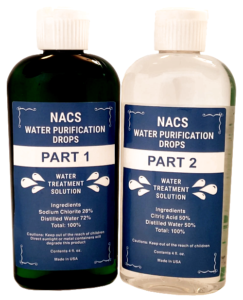In 2001, Jim Humble introduced the world to Miracle Mineral Solution, or MMS, a novel and potent pathogen-fighting agent. It’s important to clarify that MMS is Humble’s nickname for chlorine dioxide (ClO2), setting it apart from chlorine despite misleading information that circulates online. Chlorine dioxide, authorized as a food additive, is renowned for its proficiency in eradicating bacteria by converting them into harmless water molecules. For over a century, ClO2 has effectively purged water of notorious bacterial contaminants, such as salmonella and E. coli.
Humble’s revelation was that chlorine dioxide was a mineral gas that kills all pathogens. Because it was so efficient at killing pathogens, Mr. Humble nicknamed it a miracle mineral supplement or MMS for short. Chlorine dioxide has been available since the 1930s and has purified billions of gallons of water for safe drinking. Jim Humble discovered that only a lightly larger quantity of chlorine dioxide, the miracle mineral, would do the same sanitizing job in any non-metalic container, such as our and our pet friends’ bodies.
In contrast to stabilized oxygen, chlorine dioxide (ClO2) in MMS boasts a balanced charge, enhancing its oxidative capabilities while selectively obliterating harmful pathogens (anaerobic organisms) and preserving healthy cells (aerobic organisms). Chlorine dioxide (MMS) is a powerful pathogen killer and heavy metal oxidizer.
Benefits of Chlorine Dioxide (MMS)
Chlorine dioxide (MMS) has garnered attention for its application in various health challenges, with its common uses encompassing:
- Geriatric Dogs (Promoting Longevity)
- Fungal Infections
- Cataracts
- Ear Infections
- Cancer
- Lyme Disease
- Blood Diseases, such as lymphoma and multiple myeloma
- Systemic Lupus Erythematosus (SLE)
- Pain (except when inflicted by accidents)
- Pneumonia
- Heavy Metal Detoxification
Administration
Administering chlorine dioxide (MMS) requires careful oversight from a skilled practitioner or holistic veterinarian, as it should be used in small doses and for short durations. The guidelines are as follows:
- Use a clean, empty, and thoroughly dry glass.
- Add ten freshly squeezed organic lime or lemon drops.
- Incorporate two drops of MMS.
- Mix by gently swirling the glass by hand.
- Allow a three-minute waiting period.
- Introduce four ounces of freshly pressed organic apple juice.
- Administer promptly.
The most common way to create chlorine dioxide is from the two-part kit, where one bottle contains sodium chlorite and the other contains citric acid. When combined and allowed to activate for 30 seconds the result is chlorine dioxide or MMS.
It’s vital to include one drop of Part 2 for every Part 1 drop to activate the solution for dogs.
It’s important to note that the potency of chlorine dioxide concentrate diminishes over time, remaining active for approximately ten minutes. Therefore, immediate administration is advised.
Initial Administration
For the initial administration, give two activated drops up to seven times daily. Mr. Humble suggests administering hourly doses as this approach has shown the most promising results. The objective is to introduce MMS gradually and consistently, avoiding lethargy, vomiting, or diarrhea. For dogs with serious conditions, give two drops daily for two weeks before considering additional drops in the dosing regimen. In case of aggravated symptoms, proceed to increase the dosage by one drop, waiting for a positive response. This process continues until reaching the maximum weight-based dosage according to your dog’s weight. The final stage involves reducing the dosage to two drops three times daily once results are evident.
Maximum Activated Chlorine Dioxide Drops Based on Size:
- Extra Small Dog: 3 drops
- Small Dog: 4 drops
- Medium Dog: 6 drops
- Large Dog: 7 drops
- Extra Large Dog: 9 drops
Frequency
Never administer more than two drops at a time during the initial dosages. Allow any potential reactions to subside before subsequent administrations. Gradually increase the dosage, one drop at a time, while closely monitoring your dog. Only escalate the dosage if no improvements are observed, with a waiting period of three to four days between adjustments.
Once your dog’s health shows signs of improvement, maintain the same, most recently used, dose. In cases where the ailment or disease is completely cleared, a low daily maintenance dose is suggested for dogs aged eight and above. For younger dogs, administering two to three times weekly provides adequate maintenance.
Side Effects
Chlorine dioxide (MMS) may induce temporary gastrointestinal irritation lasting from ten to sixty minutes. The tolerability of side effects is influenced by concentration, dosing, dispensing methods, and your dog’s condition. According to Humble, side effects are short-lived, typically not exceeding 60 minutes, except for fatigue, which may persist for up to four hours.
Potential side effects of chlorine dioxide (MMS) include:
- Diarrhea
- Dizziness
- Fatigue
- Nausea
- Vomiting
Chlorine Dioxide Safety
Chlorine dioxide demonstrates its effectiveness in destroying diseased cells, bacteria, and pathogens. It is primarily employed in cases of serious illnesses when other natural methods fall short. It is important to acknowledge that chlorine dioxide is safe in small quantities. However, excessive dosages can lead to toxicity, potentially causing damage to red blood cells, gastrointestinal tract lining disintegration, and even pulmonary edema, which is the accumulation of fluid in the lungs, with the risk of fatality.
Warning: Chlorine dioxide (MMS) follows the principle that “more isn’t better.” Exceeding recommended dosages can be detrimental. As with most therapeutic modalities, what can heal can also harm. Always adhere to the recommended dosage.
Safety Recommendations
- Avoid administering large quantities in one instance (not exceeding 15 drops for small and medium dogs or 30 drops for large and extra-large dogs).
- Refrain from giving chlorine dioxide (MMS) if your dog has diarrhea or vomiting.
- Avoid using chlorine dioxide (MMS) in pregnant dogs.
- Do not administer to puppies less than six weeks old.
In case a Herxheimer reaction occurs, vitamin C administration can serve as an antidote. This type of reaction is characterized by symptoms such as vomiting or diarrhea and arises from pathogen die-off. Administer three rounds of vitamin C every two to three hours, using whole food vitamin C supplements, including rosehips, acerola, alma berry, and camu camu berry.
Recommended Vitamin C Doses:
- Extra-Small Dog: 300 mg
- Small Dog: 600 mg
- Medium Dog: 1,200 mg
- Large Dog: 1,800 mg
- Extra-Large Dog: 2,000 mg
Crucially, chlorine dioxide (MMS) does not accumulate in tissues and remains active for 60 minutes, with its potency peaking upon initial consumption. Over time, it gradually deteriorates into components utilized by the immune system or transforms into chloride. The unused portions degrade into minute quantities of table salt (NaCl) and water.
It is imperative to remember that this article is not a substitute for professional diagnosis or treatment. Always consult your holistic veterinarian for an accurate diagnosis and an individualized treatment plan for your pet.


Leave a Reply